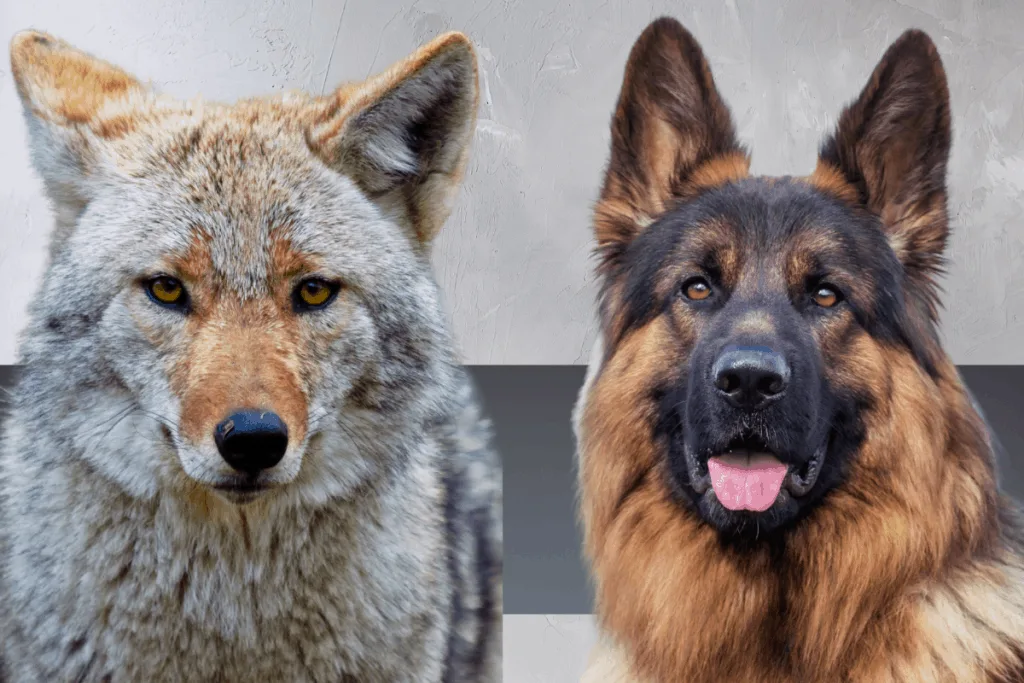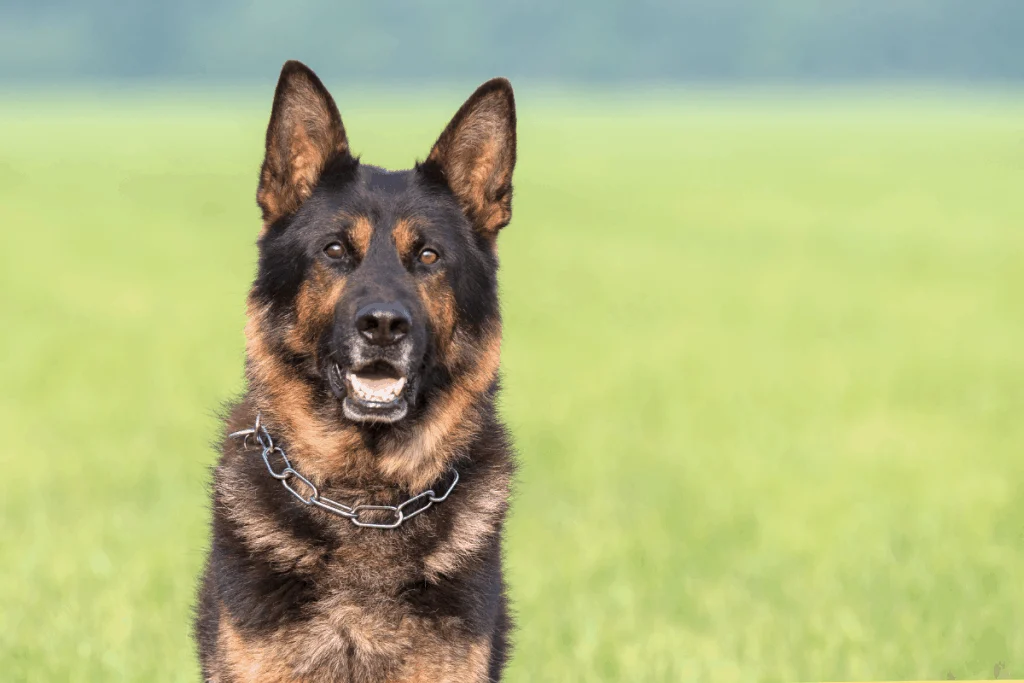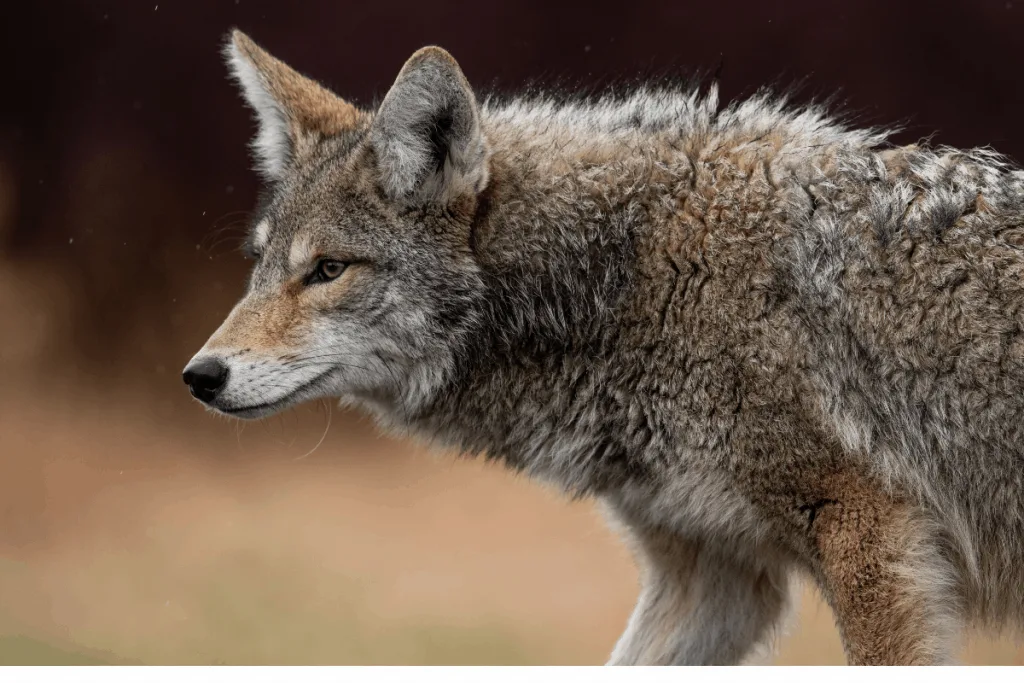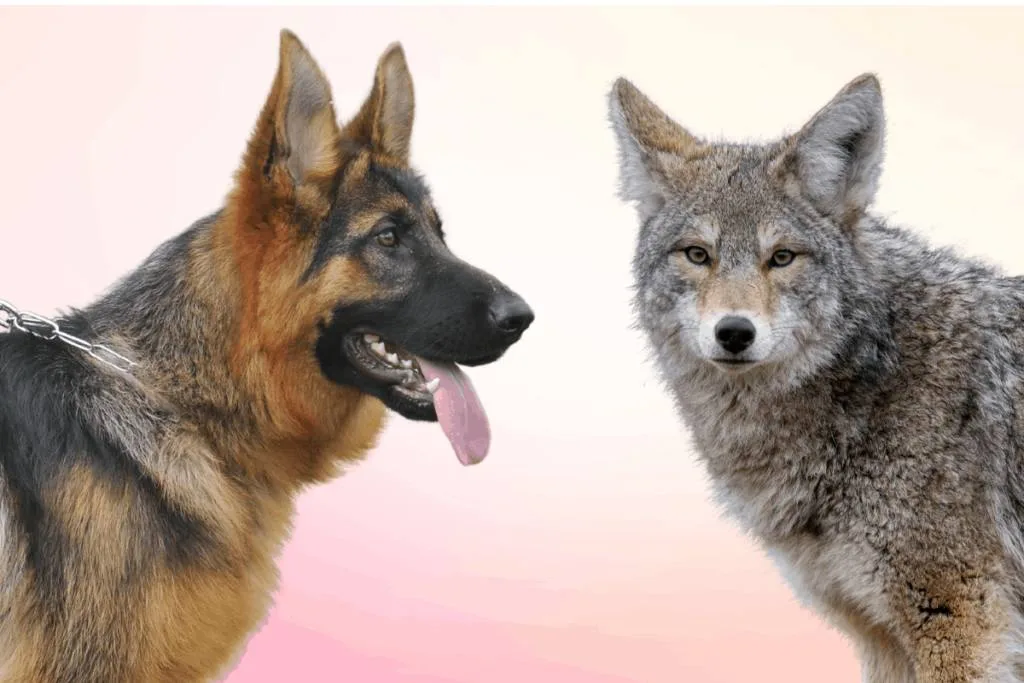
You’re perusing through the rescue boards of your local animal shelter, and you come across a dog that looks a lot like a coyote. A coyote mixed with a German Shepherd…is that even possible? What even is it?
A German Shepherd coyote mix is usually a very high spirited dog that loves to wander. Since German Shepherds and coyotes are shaped similarly, the mix of these two species results in a somewhat larger and more muscular version of a coyote. These dogs are raised in captivity, as the hybrid rarely happens in nature.
If you’re looking into adopting any dog that is mixed with a coyote, a German shepherd is probably a pretty good pick.
In the following article, we’ll explore the personality of the two animals separately and how they are when mixed together. We’ll also touch on the health concerns of this breed and physical requirements.
Click Here to Jump to a Section
What Is a Coyote Shepherd?
A coyote shepherd, or coyote German Shepherd mix, is a type of canine that blends two separate but closely related species together: coyote and dog.
When these two animals come together, they create a highly active creature that is loving but requires firm leadership.
A coyote dog mix is often called a “coydog,” and they generally don’t occur naturally. Human interference is the main source of the breeding, and these coydogs will be raised in captivity like dogs, not in the wild like coyotes.
A coyote shepherd is an attractive looking dog and usually has the following features:
- Upright ears
- Sloped back
- Medium length coat
- Long tail
- High pitched whine and yip
- Blended coat of coyote tan with German shepherd brown or black
Is a Coyote Shepherd the Right Breed for Me?
Unless you are an experienced dog owner with a strong background in dog training, the answer to this question is “no.”
The coyote shepherd, if it is indeed 50% coyote and 50% shepherd, is an extremely demanding breed.
These animals are highly active, very smart, but cannot be trusted around small children.
The person that suits the coyote shepherd is highly active, patient, and knowledgeable. These wild pets are not suitable for first-time dog owners.
Are You Active Enough?
Both of these animals are extremely athletic, and to keep the coydog from getting destructive, it will need a lot of exercise. To pair well with a coydog, you’d need to be someone who runs or hikes for at least two hours every day.
Long runs, mental stimulation, and a spacious yard with a high fence are all necessities with this mix and will make for a happy and secure coydog.
Are You Highly Experienced With Animals?
Not only are coydogs extremely active, but they are also challenging animals to control. You should be well versed in animal body language, training, and handling.
You need to know how to recognize the signals of both dogs and coyotes. Going into owning one of these dogs without the requisite knowledge is simply asking for trouble.
German Shepherd and Coyote Basic Facts
German Shepherd coyote mixes are not extremely common, and as such, suit a very unique owner. Someone who is prepared for an intelligent and extremely active dog will stand the best chance of successfully raising one of these peculiar mixes.
Let’s take a look at some of the aspects of these animals on their own so we can better understand their mixture.
German Shepherd Basic Facts

The German Shepherd dog is the 2nd most popular breed of dog in the United States. They are part of the herding group, which makes them naturally inclined to try and control other animals.
They were used in Germany to herd sheep, guiding them through the fields, and protecting them from predators, like foxes, wolves, and yes, coyotes.
German Shepherds are a medium to large-sized dog, with the females weighing in between 50-70 pounds and the males being 65-90 pounds.
Some German Shepherds can be bigger than this, though, and the larger dogs are quite intimidating.
This breed found its way over to the US in the early 20th century. They were first exhibited in 1907 in Philadelphia and Newcastle, where they were entered in the open class.
Just six years later, the German Shepherd Dog Club of America was born, and they’ve grown in popularity ever since.
German Shepherds are highly intelligent and take well to training. The German army used the dogs heavily in World War 1, and word of their loyalty and courage spread.
Americans have looked to German shepherds as guardians of their property and families for decades, with there being many stories of these dogs saving the lives of their humans.
These dogs are easily recognized by their tall, pointy ears, long snouts, and shaggy coat. They tend to shed a lot, and mud sticks well to their fur. If you can put up with the mess and high activities, you’ll be rewarded with a guard dog for life.
For more on German Shepherd shedding and training, be sure to check out these two excellent articles linked below:
Coyote Basic Facts

Coyotes are part of the canine family, but unlike dogs, the coyote is a wild animal whose traits reflect that. These mammals are extremely smart, like their cousins: foxes, wolves, and jackals.
They use many forms of communication to speak with other members of their pack, though they mostly travel alone.
Throughout much of North America, you can hear the mournful howl of a coyote at night. They often howl at the moon, and their yips and calls echo throughout canyons and mountainsides. This trademark sound is often passed on to the coydog offspring.
Coyotes are smaller than German Shepherds, but only slightly. They usually weigh between 20 and 50 pounds, which lands them in between foxes and wolves for size.
Coyotes can be white, tan, brown, or grey, with the warmer colors being found down south.
These canines are highly adaptable to different living situations, which is why they have been established so successfully in so many different climates. From desert plain to deciduous forests and even urban sprawls, coyotes can reside and survive.
When it comes to their young, both male and female coyotes are involved in caretaking. Males fetch food and bring it to the females who guard the babies.
The gestation period for females is similar to that of dogs; around 60 days. While the animals are together, they are quite affectionate with one another. Coyotes groom each other, will cuddle together, and lick each other’s faces in greeting.
What to Expect With the Coyote German Shepherd Mix
Now that we know what these animals are like on their own, we can begin to see how the characteristics would influence each other as they mix.
With both animals being active and intelligent, you’re nearly guaranteed those two features at least.
Active
German Shepherds need at least two hours of exercise every day, while coyotes travel about 14 miles (24 kilometers) every day. Put these two animals together, and you’re left with a highly active pet.
You can count on putting in hours of work to exercise your coydog seven days a week. Be sure that this is something you can commit to before getting a coyote shepherd. You won’t have any days off from exercise for the next ten years!
Loving
Even though coyotes are wild animals, they are highly affectionate. German Shepherds aren’t overly cuddly dogs, but they do love your company. A coydog is usually very fond of affection and will want to be near you all the time.
If you let a coydog, they would happily sit on the couch or sleep in your bed. While your coydog might seem to ignore you and want to roam around outdoors, they will be very affectionate at home.
Coat
With both parents having similar fur, coyote shepherds are a thick-furred pet that can withstand very low temperatures. They are a good choice for someone who lives in the northern US and wants their dog to be comfortable in the winter.
These dogs do shed a lot, though, so you may want to invest in a new vacuum before you bring your fur baby home.
We find that the Bissell MultiClean Allergen Pet Vacuum with HEPA Seal System does the job quite well.
As far as color goes, the coyote shepherd can have almost any variation in color or markings. There’s usually some sort of gradient between brown and black, but there can also be white, tan, or grey dogs.
Some of these dogs could have a lighter colored chest or a mask around the face as a result of this peculiar mix of genes.
Health Concerns
As with any dog, there are some health concerns that are specific to this breed. Coyote shepherds are unique in that they are a cross-species animal, which can potentially make them a hardier mix.
Hip Dysplasia
The top issue when it comes to German shepherds is hip dysplasia. Up to 19% of this breed will develop the disease.
The numbers aren’t out yet for coydogs, but you can expect it to be a serious concern since the condition is hereditary. Like elbow dysplasia, hip dysplasia is a congenital disorder where the joints are too loose, and the movement of the bones causes damage.
To understand all about hip dysplasia and other joint problems in German Shepherds, make sure that you read the article linked below to give you an idea of what you may be dealing with if you choose this mixed breed:
German Shepherd Joint Problems: All You Need to Know
Elbow Dysplasia
This is a hereditary disease that affects the front legs of many large breeds of dogs. Overweight dogs, over-exercised dogs, and injured dogs are at risk of developing this faster than other pups in their litter.
With a coydog, you are unlikely to over exercise it, but you could easily overfeed it. Make sure you feed your coydog a lean, nutritional diet full of protein and vitamins.
Arthritis
The result of hip or elbow dysplasia is arthritis. Just like with humans, arthritis is an inflammation of the joint, which causes a loss of cartilage.
As the joint is used and the cartilage wears away, movement becomes painful and stiff. Coydogs who are affected with dysplasia will get this eventually, though sometimes arthritis comes separately.
Make sure that you read 10 Caring Ways to Help a German Shepherd With Arthritis to get a better idea what a diagnosis of arthritis really means to your dog.
Bloat
Another health risk passed down to coydogs from their dog parents is bloat. Bloat (or Gastric Dilatation-Volvulus) is a condition that happens in many large dogs.
It usually occurs when a dog is not very active and gulps its food down at high speeds. This fast-eating can allow an excess amount of air to enter the stomach, and the stomach twists on itself, restricting blood flow to the organs.
If bloat occurs, a coydog must be rushed to a vet immediately. Emergency surgery is required to untwist the stomach and save your pet’s life.
You can reduce the chance of bloat by feeding your dog two or three smaller meals per day instead of one.
Heartworms
Some breeds of dogs are more prone to heartworms than others, and coydogs are one of them.
In Cook County, 41% of wild coyotes are found to have heartworms. This disease is exactly how it sounds: worms infect the heart and restrict blood flow.
The larvae of these worms enter a dog’s bloodstream through the bite of an infected mosquito, and the worms develop and grow over the years.
Oral medication can be given regularly to diminish the likelihood of heartworm infection in coydogs.
A great medication that goes a long way towards preventing heartworm infection is K9 Advantix II Flea Tick and Mosquito Prevention for Extra Large Dogs.
This is a topical medication, so it’s easy to apply and it begins working within hours. We also find it very convenient that you only need to apply it once every 30 days.
Trainability
To properly train a coyote shepherd, you will need a lot of patience, knowledge, and a firm tone. These animals are extremely clever, and therefore can learn many commands, but they are also wild.
A 50/50 German Shepherd coyote mix can be difficult to train, as the presence of the coyote gene is so strong. These wild dogs are food motivated, so a combination of treats and clicker training will be effective.
Even with a well-trained coydog, you are never going to be guaranteed that they will choose to listen to you rather than their instincts, though.
You should never leave a coyote shepherd unattended with a child and never let them off-leash in an area where they could get into trouble.
Your coydog will love to run around in the woods, so make sure you instill them with good recall; otherwise, they may run farther than you could ever catch them.
Temperament

With both parent animals being mostly even-tempered, you’ll probably find your coydog is calm – most of the time.
These dogs are also very observant. They will stand on alert, constantly watching for prey and potential dangers.
Coyote shepherds will be quick to react if something good or bad happens, so sudden movements around these dogs should be kept to a minimum in case they get spooked or snap.
Early socialization is imperative for all dogs, but for a German Shepherd coyote mix, it’s vital.
Since these dogs are half of a wild animal, they will have unpredictable tendencies. You will need to take your coydog puppy everywhere with you to get them used to all sorts of people and places.
Keep your puppy on a leash, but encourage them to explore and meet strangers. It’s a good idea to carry treats with you at all times, so you can pull your pet’s attention back to you whenever necessary.
You can try Zuke’s Mini Naturals Training and New Hemp Calming Dog Treats. They are made with real chicken and whole food berries, so they are quite nutritious. But we must say that we also love the size – they are tiny, and only 3 calories each, so you won’t need to be concerned about over-feeding.
At home, your coydog will be very cuddly. They love to nest and would appreciate a warm bed with a blanket. Your coyote shepherd will enjoy getting pets from you, though they may be a bit standoffish with strangers.
They should get along well with other dogs, as long as you have socialized them sufficiently as a puppy. Your coydog may lick other dogs’ faces in greeting, which is a coyote trait.
Other canines might not enjoy this, though, so keep an eye out when meeting new dogs.
Nutritional Requirements
A German Shepherd coyote mix would benefit greatly from a high protein diet. Coyotes are not picky eaters, but they do need a lot of meat, and your coydog will too.
You’ll want to choose a dog food with meat as the first five ingredients or consider a raw meat diet for your dog. Adding fish oil to the meal will help your pet’s joints stay in top condition and keep their coat silky.
Watch this video to learn more about the ingredients in your dog’s food:
Exercise Requirements
As mentioned, a coyote shepherd will need a nearly excessive amount of exercise. Prepare to take up hiking or running as part of your daily routine.
Mental stimulation is key as well to tire not just your dog’s body but their mind. You should aim for two to three hours of physical exercise per day for your coydog.
Cost
You might have a hard time finding a German shepherd coyote puppy, and when you do, there’s no telling how much it may cost. You could pay anywhere from $300 to $1000 US, depending on the breeder.
Once you have the dog, normal puppy costs ensue: vaccines, medication, vet visits, food, gear, and accessories are all things you’ll want for your dog.
For a coyote shepherd, in particular, you’ll probably want to invest in a well-built crate.
For example, check out the iCrate from Midwest Homes. It’s the perfect crate for this mix, as it has heavy duty slide bolts and a divider to accommodate your coydog as he grows – you won’t need to ever buy a bigger crate.
Crate training a wild dog like this would be very advantageous in the long run, as they tend to become destructive when they’re bored.
To get an idea of the cost associated with this mix, be sure to read How Much Does a German Shepherd Puppy Cost?
This will give you a blueprint on just how much money, time, and effort will be required for the coydog.
Final Thoughts
A coyote shepherd is a unique dog that would be a good fit for a very experienced and active owner.
The ideal dog of this breed will be intelligent, loyal, and adventurous. But a less than ideal coydog can be unruly, unpredictable, and sensitive.
You should expect to work hard with your dog and open to getting a trainer at the first sign of aggression.
Keep these pointers in mind should you choose to pursue getting one of these mixes. These dogs require a lot of work – training, exercise, and proper nutrition are a must.
But if you are up for it, getting one of these dogs might just be the adventure that you’ve been looking for!
